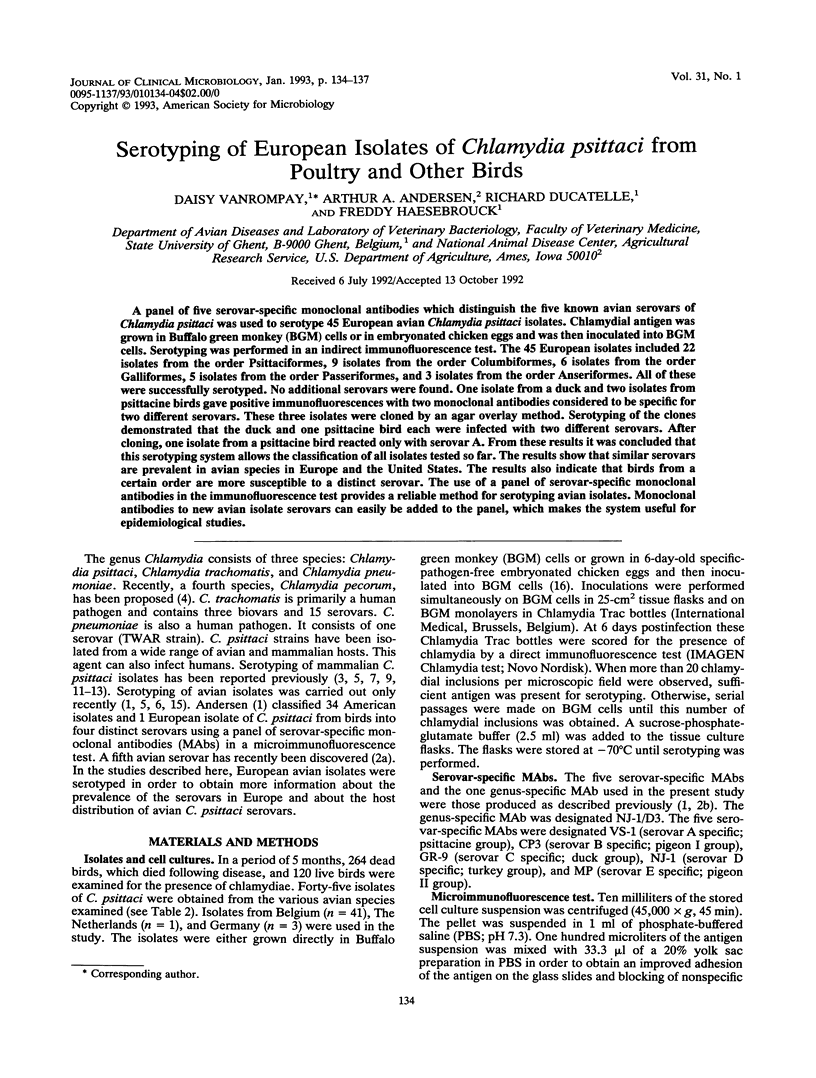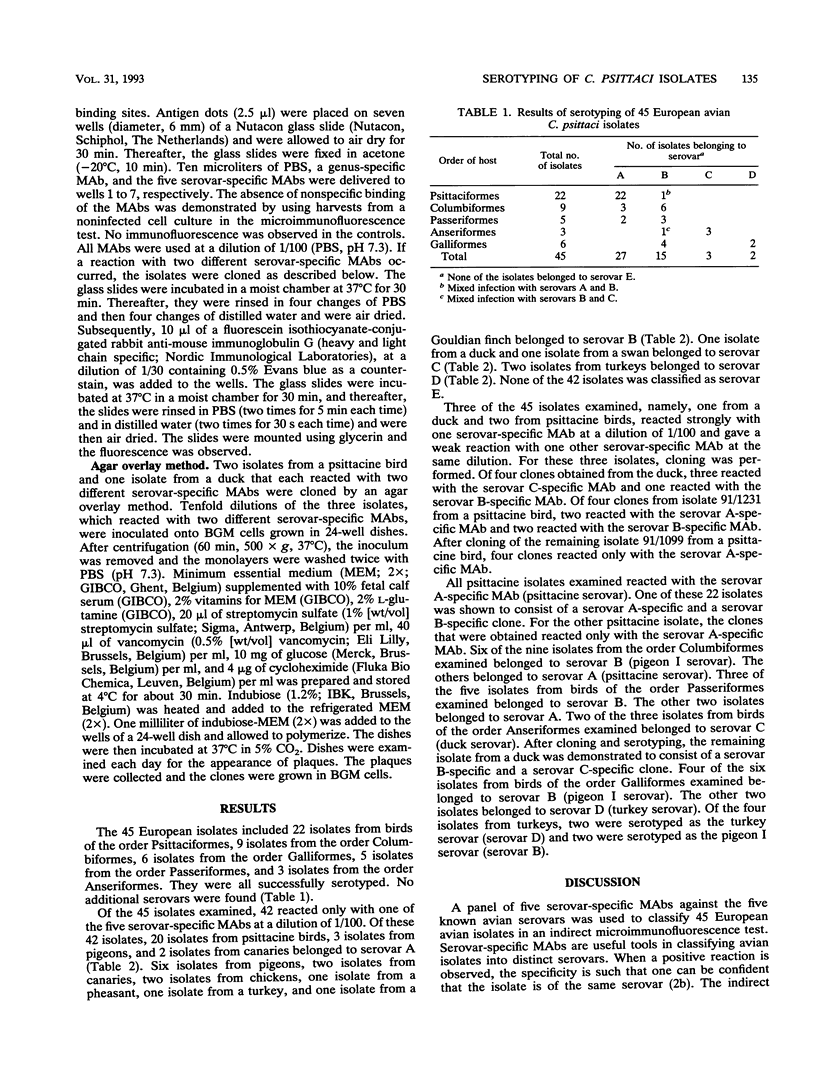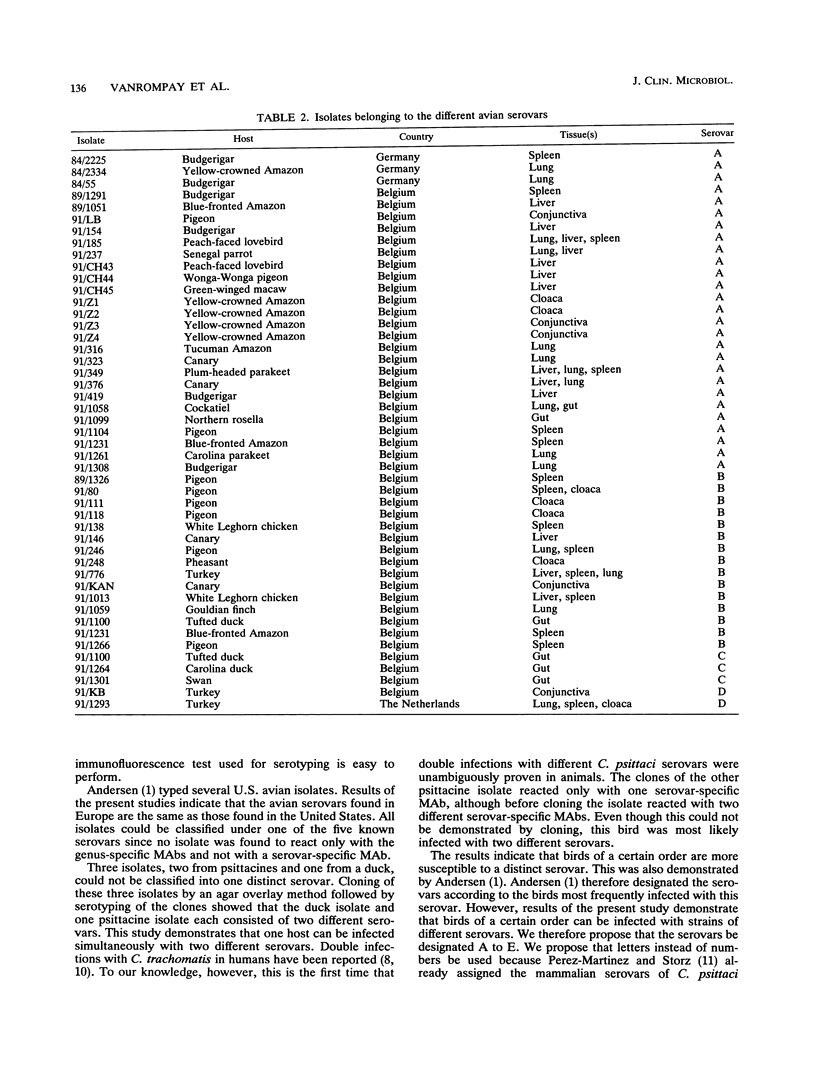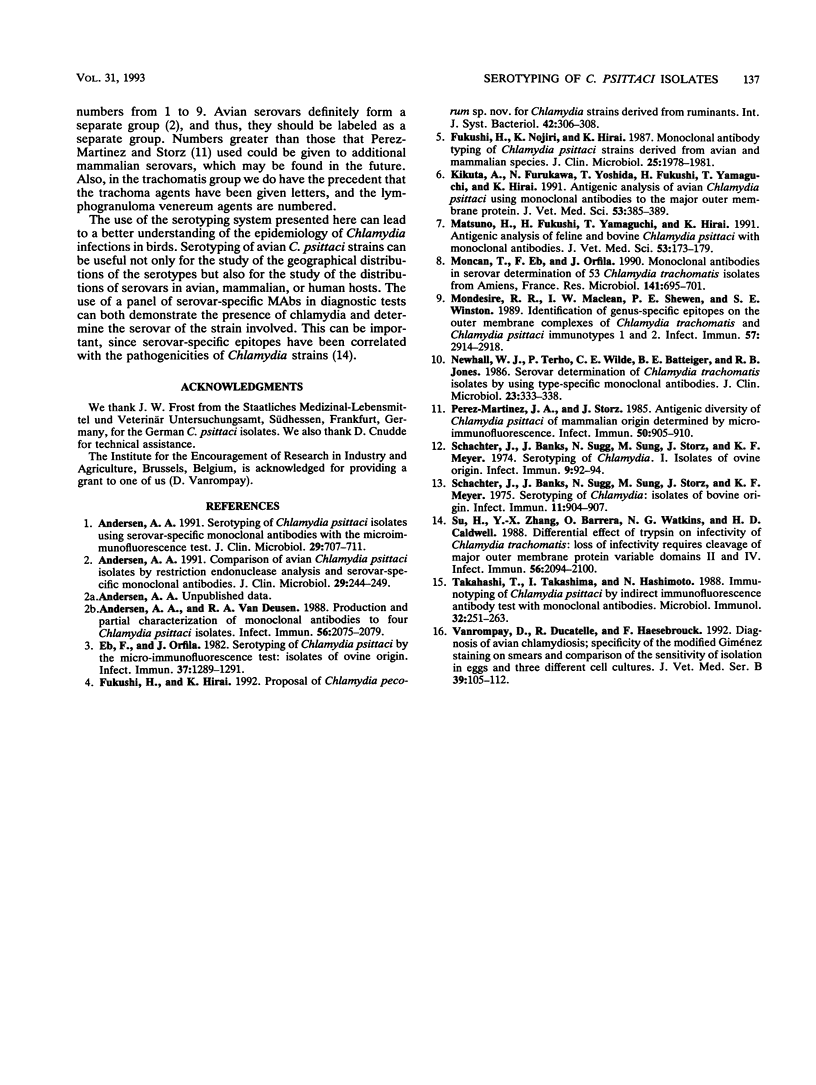Abstract
A panel of five serovar-specific monoclonal antibodies which distinguish the five known avian serovars of Chlamydia psittaci was used to serotype 45 European avian Chlamydia psittaci isolates. Chlamydial antigen was grown in Buffalo green monkey (BGM) cells or in embryonated chicken eggs and was then inoculated into BGM cells. Serotyping was performed in an indirect immunofluorescence test. The 45 European isolates included 22 isolates from the order Psittaciformes, 9 isolates from the order Columbiformes, 6 isolates from the order Galliformes, 5 isolates from the order Passeriformes, and 3 isolates from the order Anseriformes. All of these were successfully serotyped. No additional serovars were found. One isolate from a duck and two isolates from psittacine birds gave positive immunofluorescences with two monoclonal antibodies considered to be specific for two different serovars. These three isolates were cloned by an agar overlay method. Serotyping of the clones demonstrated that the duck and one psittacine bird each were infected with two different serovars. After cloning, one isolate from a psittacine bird reacted only with serovar A. From these results it was concluded that this serotyping system allows the classification of all isolates tested so far. The results show that similar serovars are prevalent in avian species in Europe and the United States. The results also indicate that birds from a certain order are more susceptible to a distinct serovar. The use of a panel of serovar-specific monoclonal antibodies in the immunofluorescence test provides a reliable method for serotyping avian isolates. Monoclonal antibodies to new avian isolate serovars can easily be added to the panel, which makes the system useful for epidemiological studies.
Full text
PDF



Selected References
These references are in PubMed. This may not be the complete list of references from this article.
- Andersen A. A. Comparison of avian Chlamydia psittaci isolates by restriction endonuclease analysis and serovar-specific monoclonal antibodies. J Clin Microbiol. 1991 Feb;29(2):244–249. doi: 10.1128/jcm.29.2.244-249.1991. [DOI] [PMC free article] [PubMed] [Google Scholar]
- Andersen A. A. Serotyping of Chlamydia psittaci isolates using serovar-specific monoclonal antibodies with the microimmunofluorescence test. J Clin Microbiol. 1991 Apr;29(4):707–711. doi: 10.1128/jcm.29.4.707-711.1991. [DOI] [PMC free article] [PubMed] [Google Scholar]
- Andersen A. A., Van Deusen R. A. Production and partial characterization of monoclonal antibodies to four Chlamydia psittaci isolates. Infect Immun. 1988 Aug;56(8):2075–2079. doi: 10.1128/iai.56.8.2075-2079.1988. [DOI] [PMC free article] [PubMed] [Google Scholar]
- Eb F., Orfila J. Serotyping of Chlamydia psittaci by the micro-immunofluorescence test: isolates of ovine origin. Infect Immun. 1982 Sep;37(3):1289–1291. doi: 10.1128/iai.37.3.1289-1291.1982. [DOI] [PMC free article] [PubMed] [Google Scholar]
- Fukushi H., Hirai K. Proposal of Chlamydia pecorum sp. nov. for Chlamydia strains derived from ruminants. Int J Syst Bacteriol. 1992 Apr;42(2):306–308. doi: 10.1099/00207713-42-2-306. [DOI] [PubMed] [Google Scholar]
- Fukushi H., Nojiri K., Hirai K. Monoclonal antibody typing of Chlamydia psittaci strains derived from avian and mammalian species. J Clin Microbiol. 1987 Oct;25(10):1978–1981. doi: 10.1128/jcm.25.10.1978-1981.1987. [DOI] [PMC free article] [PubMed] [Google Scholar]
- Kikuta A., Furukawa N., Yoshida T., Fukushi H., Yamaguchi T., Hirai K. Antigenic analysis of avian Chlamydia psittaci using monoclonal antibodies to the major outer membrane protein. J Vet Med Sci. 1991 Jun;53(3):385–389. doi: 10.1292/jvms.53.385. [DOI] [PubMed] [Google Scholar]
- Matsuno H., Fukushi H., Yamaguchi T., Hirai K. Antigenic analysis of feline and bovine Chlamydia psittaci with monoclonal antibodies. J Vet Med Sci. 1991 Apr;53(2):173–179. doi: 10.1292/jvms.53.173. [DOI] [PubMed] [Google Scholar]
- Moncan T., Eb F., Orfila J. Monoclonal antibodies in serovar determination of 53 Chlamydia trachomatis isolates from Amiens, France. Res Microbiol. 1990 Jul-Aug;141(6):695–701. doi: 10.1016/0923-2508(90)90063-v. [DOI] [PubMed] [Google Scholar]
- Mondesire R. R., Maclean I. W., Shewen P. E., Winston S. E. Identification of genus-specific epitopes on the outer membrane complexes of Chlamydia trachomatis and Chlamydia psittaci immunotypes 1 and 2. Infect Immun. 1989 Sep;57(9):2914–2918. doi: 10.1128/iai.57.9.2914-2918.1989. [DOI] [PMC free article] [PubMed] [Google Scholar]
- Newhall W. J., 5th, Terho P., Wilde C. E., 3rd, Batteiger B. E., Jones R. B. Serovar determination of Chlamydia trachomatis isolates by using type-specific monoclonal antibodies. J Clin Microbiol. 1986 Feb;23(2):333–338. doi: 10.1128/jcm.23.2.333-338.1986. [DOI] [PMC free article] [PubMed] [Google Scholar]
- Perez-Martinez J. A., Storz J. Antigenic diversity of Chlamydia psittaci of mammalian origin determined by microimmunofluorescence. Infect Immun. 1985 Dec;50(3):905–910. doi: 10.1128/iai.50.3.905-910.1985. [DOI] [PMC free article] [PubMed] [Google Scholar]
- Schachter J., Banks J., Sugg N., Sung M., Storz J., Meyer K. F. Serotyping of Chlamydia. I. Isolates of ovine origin. Infect Immun. 1974 Jan;9(1):92–94. doi: 10.1128/iai.9.1.92-94.1974. [DOI] [PMC free article] [PubMed] [Google Scholar]
- Schachter J., Banks J., Sugg N., Sung M., Storz J., Meyer K. F. Serotyping of Chlamydia: isolates of bovine origin. Infect Immun. 1975 May;11(5):904–907. doi: 10.1128/iai.11.5.904-907.1975. [DOI] [PMC free article] [PubMed] [Google Scholar]
- Su H., Zhang Y. X., Barrera O., Watkins N. G., Caldwell H. D. Differential effect of trypsin on infectivity of Chlamydia trachomatis: loss of infectivity requires cleavage of major outer membrane protein variable domains II and IV. Infect Immun. 1988 Aug;56(8):2094–2100. doi: 10.1128/iai.56.8.2094-2100.1988. [DOI] [PMC free article] [PubMed] [Google Scholar]
- Takahashi T., Takashima I., Hashimoto N. Immunotyping of Chlamydia psittaci by indirect immunofluorescence antibody test with monoclonal antibodies. Microbiol Immunol. 1988;32(3):251–263. doi: 10.1111/j.1348-0421.1988.tb01385.x. [DOI] [PubMed] [Google Scholar]
- Vanrompay D., Ducatelle R., Haesebrouck F. Diagnosis of avian chlamydiosis: specificity of the modified Giménez staining on smears and comparison of the sensitivity of isolation in eggs and three different cell cultures. Zentralbl Veterinarmed B. 1992 Mar;39(2):105–112. doi: 10.1111/j.1439-0450.1992.tb01144.x. [DOI] [PubMed] [Google Scholar]


